Join More Than 50,000+ Subscribers and get latest camera news and rumors
NEW CAMERA VIDEOS ON YOUTUBE
|
By abhishek, on September 15th, 2015
Sony A6000 vs Olympus E-M10 Mark II, lot of difference present among the Sony A6000 and E-M10 Mark II. The Sony A6000 features APS-C size Hybrid CMOS sensor on the other hand the Olympus E-M10 II have a 4/3 size sensor, we don’t have a doubt that Sony A6000 will going to perform theoretically.
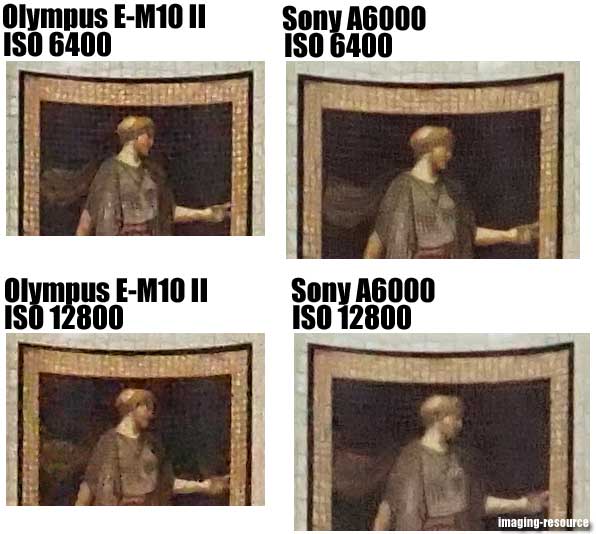 The Olympus E-M10 showing bit more details compared to A6000 whereas the Sony A6000 show less noise with more flat image, Sony may be implemented a strong noise reduction filter algo. Both camera image is usable upto 6400 only. The Olympus E-M10 showing bit more details compared to A6000 whereas the Sony A6000 show less noise with more flat image, Sony may be implemented a strong noise reduction filter algo. Both camera image is usable upto 6400 only.
Buy Olympus E-M10 Mark II from Amazon | B&H || Buy Sony A6000 from Amazon
Sony A6000 Recommended Lenses
By admin, on September 14th, 2015
On July, 30 Canon announced ME20F-SH a Ultra-High Sensitivity Camera. The features ISO sensitivity of over 4000000, till now only Sony A7s Camera was capable to touch half-million mark.
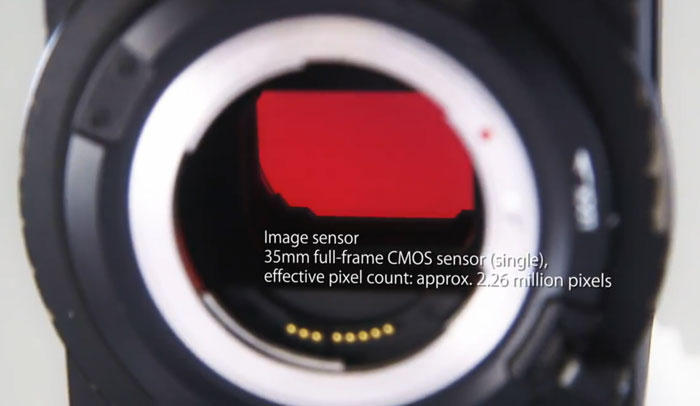
Canon ultra sensitive camera features a 2 Megapixel Fullframe sensor and can record Full HD videos while subjects are illuminated with less than 0.0005 lux. That clearly mans that camera can capture subjects in moon-less night.
Canon Japan just uploaded a new sample / low-light test video of the ME20F-SH camera. It’s really amazing to see a camera excellent performance in low-light, the sample video (few) frames shot in complete dark environment by touching 4,5 Million ISO Mark.
 Video snap-shot captured at 102000 ISO The Canon low-light monster is fully capable to give noise less video at ISO 102,000. In the image below the camera is operating at complete darkness by having ISO @ 4,560,000. The video captured at Max ISO limit does have significant amount of noise. And, it can be only used for test purpose.

The Canon low-light monster ME20F-SH shipping will start from December 2015 with a price tag of $30,000.
source and sample video link – Canon Japan
See the announcement article here | Canon 120MP DSLR Not Coming Soon
We will post more updates as soon as we get it, FACEBOOK | TWITTER | GOOGLE+ to get live news + rumors 24X7
By admin, on September 13th, 2015
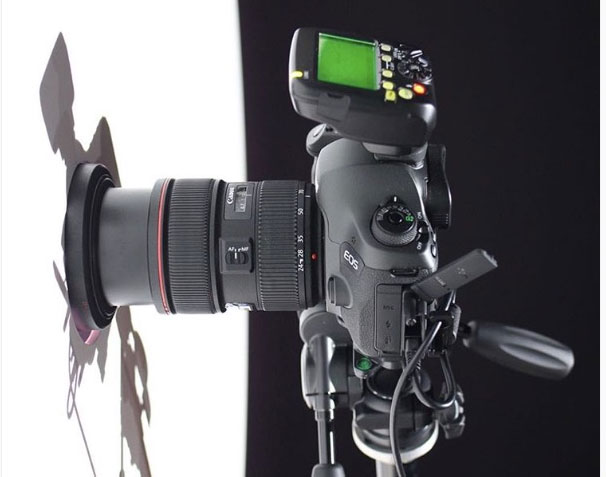
Canon 120MP DSLR shown at Canon EXPO is not coming anytime soon, according to latest rumors floating over Canon 120MP DSLR at least 2 years away from now.
The sources of the same website added that Canon is also accelerating its lens development projects and we will sure see new lenses /older lens replacements coming in next few months.
Canon 120MP DSLR image show above is just a prototype, as you already know that the sensor inside body is of APS-H size.
The camera shown at EXPO was limited to ISO 100 only. The 120 Megapixel image-file contains enormous amount of data and the size of single image is 210 MB, you need to upgrade your hard drives and back-up before buy the camera. The biggest question is does this camera will be termed as the successor of flagship 5DS/R or a new megapixel-monster series is coming from Canon with APS-H sensor.
In general I have a habit of too see incremental upgrades from Canon, I don’t expect a after 50MP 5DS/R camera Canon will announce a 120MP based APS-H sensor 5DS Mark II camera.
We have to wait and see.
We will post more updates as soon as we get it, FACEBOOK | TWITTER | GOOGLE+ to get live news + rumors 24X7
source – CR.com
By admin, on September 12th, 2015
Sony announced the Sony A7S II camera in IBC Press Conference today, unluckily the camera features the same sensor as of Sony A7S II camera. Sony added latest available technology inside the camera including 5-axis IS and internal 4K video recording with full pixel readout and m…

After the announcement of Sony A7SII, now it is important for you to know how it is superior to its predecessor Sony A7S and what new features are added in comparison to its predecessor.
Major DifferenceSony Alpha 7SII vs. Sony Alpha 7S Specification Comparison Table.
| Features / Models |
Sony Alpha 7SII |
Sony Alpha 7S |
| Megapixel |
12.2 megapixels |
12.2 megapixels |
| Sensor size / type |
Full-Frame (35.8 x 23.9 mm) |
Full-Frame (35.8 x 23.9 mm) |
| Low-pass filter |
Yes |
Yes |
| Image processor |
Bionz X |
Bionz X |
| AF System |
Contrast Detect (sensor) |
Contrast Detect (sensor) |
| AF points |
169 |
25 |
| ISO |
50-409600 |
50-409600 |
| Shutter Min/Max |
30 sec 1/8000 sec |
30 sec 1/8000 sec |
| Top Continuous Shooting Speed |
5fps |
5fps |
| Video |
4096 x 2160 (30p) Internal Recording |
4096 x 2160 (30p) External Recording |
Video AF
|
2X Faster Compared to A7S |
Contrast Detect
|
| Display |
Tilting 3″ Rear Touch screen LCD (921,600) |
Tilting 3″ Rear Touch screen LCD (921,600) |
| Viewfinder |
100% |
100% |
| Hot-shoe |
Yes |
Yes |
| Wireless |
Built-in + NFC |
Built-in+ NFC |
| Battery Life (CIPA) |
N/A |
360 shots |
| Dimensions |
Not Specified By Manufacturer |
127 x 94 x 48 mm |
| Weight |
Not Specified By Manufacturer |
489g |
Sensor: Since both the siblings have 12.2MP Full-Frame Exmor CMOS Sensor and BIONZ X Image Processor. Due to their presence, it minimizes the noise production and also enables sensitivity from ISO 100-102400, which is further expandable to ISO 50-409600. The Sony didn’t increase the ISO range of Sony A7SII. Our earlier expectation was that it will come with more ISO range than its predecessor, to make the image sensor more sensitive to light.
Auto-focus: Sony A7S II features fast and Intelligent AF system employs 169 AF points, the AF points are composed of 25 contrast-detection points and nine central AF points that have been split into 16 segments each, the AF system not only faster than of Sony A7s but it also features greater accuracy.
Sony A7S II supports Internal UHD 4K Recording, which the Sony A7S II was missing. The video of Sony A7S II contain more details, better color, contrast and sharpness compared to the Sony A7S. The Sony A7S II is free from line skipping or pixel binning, the A7S II features full pixel readout the terminates the issue loss of details, advance AF detection algorithm speed-up the AF speed of the camera 2 times more compared to its predecessor.
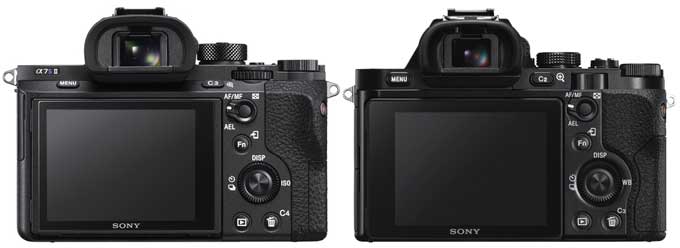
Sony A7SII can record 120fps at 100Mbps without pixel binning in full frame format also results in 4x/5x slow motion footage in Full HD. It has the ability to shoot 4x/5x slow motion footage internally.
Introduction of image stabilization: presence of 5-axis SteadyShot INSIDE image stabilization system in Sony A7SII makes it smooth shooting of stills and video by reducing five types of camera shake and it also it will give the option to the users to use any lens, or adapted lenses without facing any problems created by camera shake. But there is absent of such type of stabilization system in Sony A7S.
Rest of the core specification remains same.
Verdict: The Sony A7S II camera does have many upgrades over the Sony A7S camera but the sensor and image processor remains same. Finally the image quality of both the camera will be similar. For still shooters and owners of Sony A7S camera we don’t recommend to update you current camera against A7S II and you must wait for a better model, possibly the Sony A7S III with a new sensor and image processor.
Click here to see – Sony A7S vs Sony A7S II High ISO Test
Click here to see the Sony A7S II announcement page | Buy this Camera from B&H | Sony A7S II Sample Images
PS:
The biggest disappointment is the use of same sensor instead of developing a new one, Sony does have the capability to make Hybrid sensor as we already see in Sony A7R II camera. It’s better to say Sony updated the Sony A7S Camera, it’s not a new version
By admin, on September 11th, 2015
Sony A7S II today announced by Sony with Major upgrade in core specification of the camera. The new camera arrives with 5-axis IS system. Enhanced image, video and AF algorithm, the camera now has been upgraded to 169 AF points and features very fast AF speed along with greater accuracy.
Click here to see the Sony A7S II announcement page | Buy / Buy this Camera from B&H
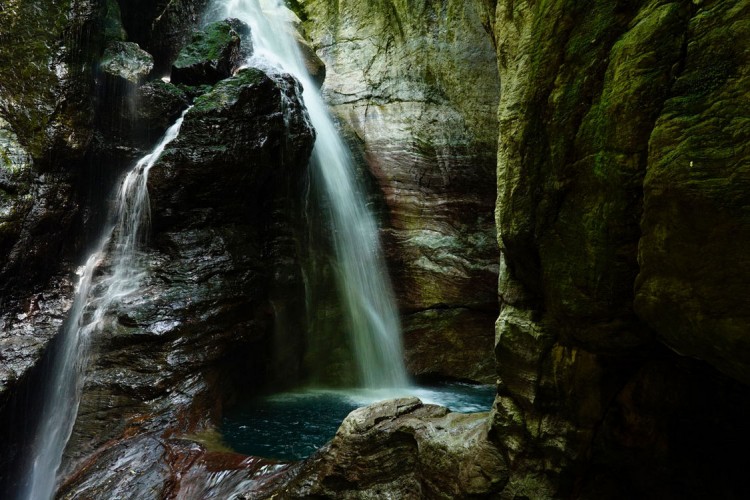 Vario-Tessar T* FE 24-70mm F4 ZA OSS, A mode, 1/10 sec., F11, ISO 1600, Manual white balance Sony A7S II samples images surfaced over the web, the images you see are only available at limited resolution [Click on the image to enlarge.], we will add post soon as any new image / high resolution image added to web.
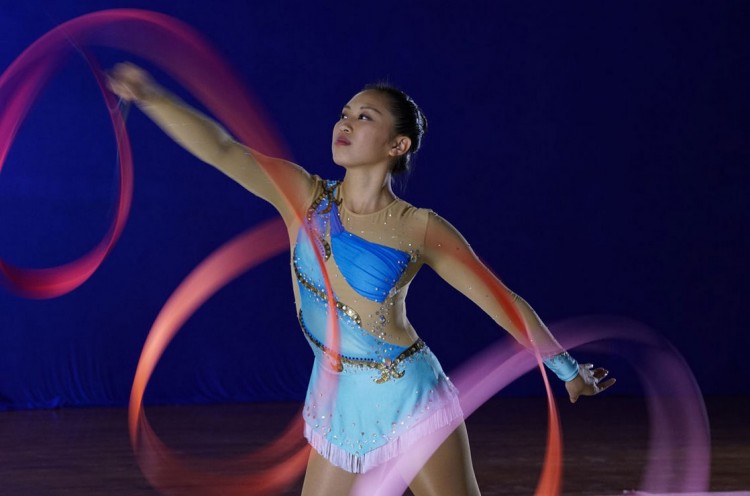 FE 70-200mm F4 G OSS, M mode, 1/15 sec., F10, ISO 3200, Manual white balance Continue reading Sony A7S II Sample Images
By admin, on September 11th, 2015
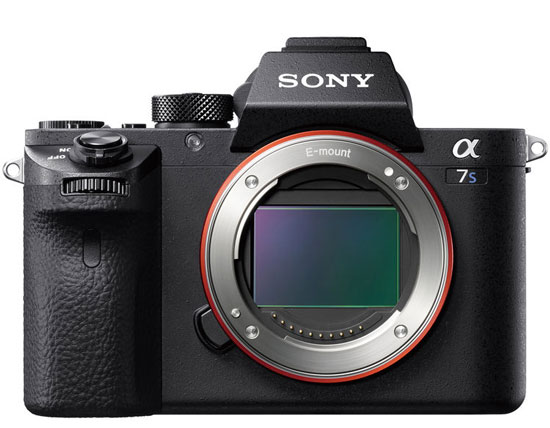 Buy this Camera from B&H Buy this Camera from B&H
Sony Announced new A7S II at IBC Press Conference today with 5 axis image stabilization system and 4K internal video recording with full-pixel readout. However the sensor remains same and the top ISO limit remains stucked to 409600. The A7S II now features169 AF points for fast, precise focusing with enhanced accuracy.
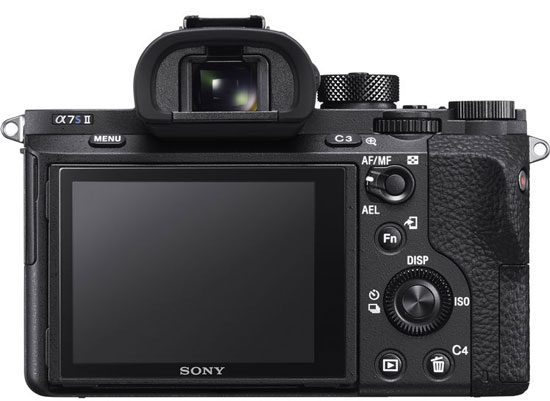 For the first time in A7 series camera Sony introduce 120fps recording @ Full HD format without pixel binning in full frame format. Video functionality has been further enhanced with new profiles; S-Gamut3.Cine/S-Log3 and S-Gamut3/S-Log3. These new profiles deliver wide dynamic range and colour correction is easier to perform. The AF system of the A7S II is approx 2 times faster in video mode compared to A7S camera. For the first time in A7 series camera Sony introduce 120fps recording @ Full HD format without pixel binning in full frame format. Video functionality has been further enhanced with new profiles; S-Gamut3.Cine/S-Log3 and S-Gamut3/S-Log3. These new profiles deliver wide dynamic range and colour correction is easier to perform. The AF system of the A7S II is approx 2 times faster in video mode compared to A7S camera.
For more details read the press release below
Out of darkness cometh light
- Ultra-high sensitivity up to 409600i with low noise across the whole range
- Wide dynamic range across entire ISO range delivering smooth tonal gradation from dark to bright conditions
- In-camera 5-axis optical image stabilisation for expanded shooting possibilities
- Internal 4K movie recording featuring full pixel readout without pixel binning in full-frame format
- Wide range of professional movie functionality including S-Gamut3.Cine/S-Log3, new Gamma Assist Display, enhanced Zebra Function, Full HD 120fps recording and 4x/5x slow motion recording and full pixel readout without pixel binning in full-frame format
- High-speed AF with enhanced accuracy in wide ranging scenes and advanced shooting functions
Sony today announced the latest addition to its award winning series of compact, full-frame α7 cameras with the introduction of the α7S II. Offering ultra-high sensitivity and wide dynamic range across the entire ISO range and 5-axis image stabilisation for greater shooting control, the α7S II delivers stunning image quality for photographers who shoot in the most challenging light conditions. Be it the brightest of mornings or darkest of nights, the α7S II enables new levels of photographic expression at whatever shutter speed you wish to deploy. The α7SII also incorporates a host of pro-style movie functions including the ability to shoot 4K video with full pixel readout and no pixel binning in full-frame format, making it an extremely appealing proposition for photographers and videographers alike.
The α7S II delivers an awe-inspiring sensitivity range of ISO 50-409600[i], thanks to the combination of its 35mm full-frame 12.2 megapixel[ii] image sensor and BIONZ X image processing engine. The sensor optimises the dynamic range across the entire ISO range and broadens the range of tonal gradation in bright environments and minimises noise in dark scenes meaning that it delivers impressive results even in the most extreme conditions. The upgraded image processing algorithm of BIONZ X maximises the sensor’s capabilities and improves depiction throughout the full sensitivity range with particular emphasis on the mid-to-high range. This means that the resulting stills and movies demonstrate extra-fine detail with minimal noise.
Video Master
The α7S II can record 4K[iii] movies internally in the XAVC S format[iv] meaning that content is wonderfully detailed. Because information from all pixels is utilised without line skipping or pixel binning, the camera can maximise the expanded power of the full-frame image sensor and produce 4K movies with higher image clarity and negligible moiré. Full pixel readout without pixel binning is also employed when shooting Full HD[v] movies which means that it collects information from approximately five times as many pixels that are required to generate Full HD[vi] and condenses the information to produce extremely high quality movies.
In a first for the α7 series, the α7S IIcan record 120fps at 100Mbps[vii] with full pixel readout without pixel binning in full frame format which can be edited into wonderful 4x/5x slow motion footage[viii] in Full HD. The α7S II also has the ability to shoot 4x/5x slow motion footage internally which can be immediately reviewed on the camera screen.
Video functionality has been further enhanced with new profiles; S-Gamut3.Cine/S-Log3 and S-Gamut3/S-Log3. These new profiles deliver wide dynamic range and colour correction is easier to perform. The α7S ll even offers impressive 14-stop latitude in the S-Log3 gamma setting. The camera also supports S-Gamut/S-Log2 which is very popular among cinematographers and videographers. Gamma Display Assist is a new function that allows users to monitor images or check focus when recording S-Log movies and the Zebra function has been improved for even greater control.
5-Axis Image Stabilisation
The new α7S II is equipped with the innovative 5-axis image stabilisation system that is proving extremely popular in the α7 II and α7R II cameras. The system corrects camera shake along five axes during shooting, including angular shake (pitch and yaw) which has the greatest impact on image quality and tends to occur with a telephoto lens, shift shake (X and Y axes) which becomes noticeable as magnification increases, and rotational shake (roll) that often affects night shooting or video recording.
Autofocus accuracy
The autofocus system on the α7S II has been upgraded and now offers 169 AF points for fast, precise focusing with greater accuracy.[ix] The power of the image sensor means that the absence of noise in images generated, enables the Fast Intelligent AF to detect contrast more easily and react speedily even in low-light situations (as low as EV-4), when it’s even tough to check with the naked eye. When shooting video, the AF performance is twice as fast as the predecessor model.[x]
Electronic Viewfinder
The XGA OLED Tru-Finder in the α7S II has been upgraded and offers the world’s highest viewfinder magnification[xi] of 0.78x (roughly 38.5 degrees in diagonal field of view) and shows clear images across the entire display area. The use of ZEISS T* Coating ensures sharp reduction of reflections on the viewfinder and unlike an optical viewfinder, the OLED Tru-Finder can be used to instantly show how exposure compensation, white balance and other selected settings are affecting the displayed image.
User upgrades
A number of enhancements have been made to the look and feel of the α7S II to make it more user friendly, reliable and intuitive. Its magnesium-alloy body is both light and highly robust and the grip and shutter buttons have been re-designed so that the camera feels more natural in the hand. For situations when you just want to blend into the background, silent shooting mode can be activated for 5fps continuous shooting[xii] and reliability has been enhanced with reduced-vibration shutter movement.[xiii] The lens mount has been further reinforced to ensure greater resilience, particularly when attaching third party lenses and users can now charge the camera via a USB power supply whilst the camera is in operation, thus extending battery life. For greater comfort and safety, Sony is also launching the LCS-EBF; a new premium leather body case for the α7S II which is also compatible with the α7R II and α7 II.
The α7S II is also Wi-Fi® and NFC compatible and fully functional with Sony’s PlayMemories Mobile application available for Android™ and iOS™ platforms, as well as Sony’s growing range of PlayMemories Camera Apps, which add a range of fun creative capabilities to the camera. Learn more at www.sony.net/pmca.
The new α7S II full-frame interchangeable lens digital camera from Sony will be available in Europe in November 2015, priced at approximately €3,400.
[i]Standard ISO 100 – 102400, Expandable to ISO 50-409600
[ii] Approximate effective megapixels
[iii] QFHD: 3840 x 2160. Internal recording and HDMI output, both at 4K resolution, are available in full-frame
[iv]SDXC memory card higher than Class 10 is required for movie recording in XAVC S format
[v]In 24p/30p
[vi] 1920 x 1080
[vii] UHS Class 3 memory card is required for recording at 100Mbps
[viii] 30p (25p) or 24p
[ix] Compared to α7S
[x]Compared to the α7S, when shooting Full HD movies.
[xi]Amongst digital cameras. The viewfinder magnification is approx. 0.78x (with 50mm lens at infinity, -1m-1). As of date of press release, based on Sony research.
[xii]Speed Priority Continuous mode. Focus and exposure settings fixed at first shot.
[xiii] 500,000-cycle durability. According to Sony internal testing, with the electronic front curtain shutter activated.
Stay tuned for more info.
Convenience Features(details)
| General |
Camera type |
Interchangeable-lens digital camera |
| Lens mount |
E-mount |
| Image sensor |
Type |
35 mm full frame (35.6 x 23.8 mm), Exmor CMOS sensor |
| Number of pixels (effective) |
Approx. 12.2 megapixels |
| Number of pixels (total) |
Approx. 12.4 megapixels |
| Image sensor aspect ratio |
3:2 |
| Anti-dust system |
Charge protection coating on optical filter and image sensor shift mechanism |
| Recording system (still images) |
Recording format |
JPEG (DCF Ver. 2.0, Exif Ver. 2.3, MPF baseline compliant), RAW (Sony ARW 2.3 format) |
| Image size (pixels) |
[3:2 aspect ratio] 35 mm full frame L: 4240 x 2832 (12M), M: 2768 x 1848 (5.1M), S: 2128 x 1416 (3.0M)
APS-C L: 2768 x 1848 (5.1M), M: 2128 x 1416 (3.0M), S: 1376 x 920 (1.3M) |
[16:9 aspect ratio] 35mm full frame L: 4240 x 2384 (10M), M: 2768 x 1560 (4.3M), S: 2128 x 1200 (2.6M)
APS-C L: 2768 x 1560 (4.3M), M: 2128 x 1200 (2.6M), S: 1376 x 776 (1.1M) |
| [Sweep Panorama] Wide: Horizontal 12416 x 1856 (23M), vertical 5536 x 2160 (12M), Standard: Horizontal 8192 x 1856 (15M), vertical 3872 x 2160 (8.4M) |
| Image quality modes |
RAW, RAW & JPEG, JPEG Extra fine, JPEG Fine, JPEG Standard |
| RAW output |
14 bit |
| Picture Effect |
13 modes: Posterization (Color, B/W), Pop Color, Retro Photo, Partial Color (R, G, B, Y), High Contrast Monochrome, Toy Camera, Soft High-key, Soft Focus, HDR Painting, Rich-tone Monochrome, Miniature, Watercolor, Illustration |
| Creative Style |
Standard, Vivid, Neutral, Clear, Deep, Light, Portrait, Landscape, Sunset, Night Scene, Autumn Leaves, Black & White, Sepia (Contrast -3 to +3 steps, Saturation -3 to +3 steps, Sharpness -3 to +3 steps) (Style Box 1-6 also provided) |
| Dynamic range functions |
Off, Dynamic Range Optimizer (Auto/Level (1–5)), Auto High Dynamic Range: Auto Exposure Difference, Exposure Difference Level (1.0-6.0 EV, 1.0 EV step) |
| Color space |
sRGB standard (with sYCC gamut) and Adobe RGB standard compatible with TRILUMINOS™ Color |
| Recording system (movies) |
Recording format |
XAVC S / AVCHD format Ver. 2.0 compliant / MP4 |
| Video compression |
XAVC S: MPEG-4 AVC/H.264
AVCHD: MPEG-4 AVC/H.264
MP4: MPEG-4 AVC/H.264 |
| Audio recording format |
XAVC S: LPCM, 2ch
AVCHD: Dolby Digital (AC-3), 2ch, Dolby Digital Stereo Creator
MP4: MPEG-4 AAC-LC, 2ch |
| Image size (pixels) |
[NTSC] XAVC S 4K: 3840 x 2160 (30p/100Mbps, 30p/60Mbps, 24p/100Mbps, 24p/60Mbps)
XAVC S HD: 1920 x 1080 (60p/50Mbps, 30p/50Mbps, 24p/50Mbps, 120p/100Mbps, 120p/60Mbps)
AVCHD: 1920 x 1080 (60p/28Mbps/PS, 60i/24Mbps/FX, 60i/17Mbps/FH, 24p/24Mbps/FX, 24p/17Mbps/FH)
MP4: 1920 x 1080 (60p/28Mbps, 30p/16Mbps), 1280 x 720 (30p/6Mbps) |
[PAL] XAVC S 4K: 3840 x 2160 (25p/100Mbps, 25p/60Mbps)
XAVC S HD: 1920 x 1080 (50p/50Mbps, 25p/50Mbps, 100p/100Mbps, 100p/60Mbps)
AVCHD: 1920 x 1080 (50p/28Mbps/PS, 50i/24Mbps/FX, 50i/17Mbps/FH, 25p/24Mbps/FX, 25p/17Mbps/FH)
MP4: 1920 x 1080 (50p/28Mbps, 25p/16Mbps), 1280 x 720 (25p/6Mbps) |
| High Frame Rate Recording |
[NTSC] 1920 x 1080 (24p/12Mbps, 30p/16Mbps) |
| [PAL] 1920 x 1080 (25p/16Mbps) |
| Picture Profile |
Yes (Off / PP1-PP9) Parameters: Black level, Gamma (Movie, Still, Cine1-4, ITU709, ITU709 [800%], S-Log2, S-Log3), Black Gamma, Knee, Color Mode (Movie, Still, Cinema, Pro, ITU709 Matrix, White&Black, S-Gamut, S-Gamut3.Cine, S-Gamut3), Saturation, Color Phase, Color Depth, Detail, Copy, Reset |
| Movie functions |
Audio Level Display, Audio Rec Level, Auto Slow Shutter, HDMI info. Display (On/Off selectable), Time Code/User Bit, Picture Profile, Creative Style, Picture Effect, Rec Control, Dual Video Rec, Marker Setting, PAL/NTSC Selector, Gamma Display Assist |
| Color space |
xvYCC standard (x.v.Color when connected via HDMI cable) compatible with TRILUMINOS™ Color |
| Clean HDMI output |
|
[NTSC] 3840 x 2160 (30p/24p) / 1920 x 1080 (60p/24p) / 1920 x 1080 (60i), YCbCr 4:2:2 8bit/ RGB 8bit |
| [PAL] 3840 x 2160 (25p) / 1920 x 1080 (50p) / 1920 x 1080 (50i), YCbCr 4:2:2 8bit/ RGB 8bit |
| Media |
Media |
Memory Stick PRO Duo,Memory Stick PRO-HG Duo,Memory Stick Micro (M2),SD memory card, SDHC memory card (UHS-I compliant), SDXC memory card (UHS-I compliant), microSD memory card, microSDHC memory card, microSDXC memory card |
| Slot |
Multi slot for Memory Stick Duo/ SD memory card |
| Noise reduction |
Noise reduction |
Long exposure NR: On/Off, available at shutter speeds longer than 1 sec., High ISO NR: Normal/Low/Off selectable |
| Multi Frame NR |
Auto/ISO 100 to 409600 |
| White balance |
Modes |
Auto WB/Daylight/Shade/Cloudy/Incandescent/Fluorescent (Warm White/Cool White/Day White/Daylight)/Flash/Color Temperature (2500 to 9900K) & Color Filter (G7 to M7: 57 steps, A7 to B7: 29 steps)/Custom/Underwater |
| AWB micro adjustment |
G7 to M7 (57 steps), A7 to B7 (29 steps) |
| Bracketing |
3 frames, H/L selectable |
| Focus system |
Type |
Contrast-detection AF |
| Focus point |
169 points (contrast-detection AF) |
| Sensitivity range |
EV -4 to EV 20 (at ISO 100 equivalent with F2.0 lens attached) |
| AF modes |
Single-shot AF (AF-S), Continuous AF (AF-C), Direct Manual Focus (DMF), Manual Focus |
| Focus area |
Wide (169 points for contrast-detection AF) / Center / Flexible Spot (S/M/L) / Zone / Expand Flexible Spot / Lock-on AF (Wide / Zone / Center / Flexible Spot (S/M/L) / Expand Flexible Spot) |
| Other features |
Lock-on AF, Eye AF, Focus lock; Eye-Start AF and AF micro adjustment (both only available with optional LA-EA2 or LA-EA4 attached), AF illuminator (built-in, LED type, range: Approx. 0.30-3m), AF ON |
| Exposure control |
Metering type |
1200-zone evaluative metering |
| Metering sensor |
Exmor CMOS sensor |
| Metering sensitivity |
EV -3 to EV 20 (at ISO 100 equivalent with F2.0 lens attached) |
| Metering modes |
Multi-segment, Center-weighted, Spot |
| Exposure modes |
AUTO (iAUTO, Superior Auto), Programmed AE (P), Aperture priority (A), Shutter-speed priority (S), Manual (M), Scene Selection, Sweep Panorama, Movie / High Frame Rate (Programmed AE (P) / Aperture priority (A) / Shutter-speed priority (S) / Manual (M) ) |
| Scene Selection |
Portrait, Landscape, Macro, Sports Action, Sunset, Night Portrait, Night Scene, Hand-held Twilight, Anti Motion Blur |
| Exposure compensation |
+/-5.0 EV (in 1/3 EV or 1/2 EV steps), with exposure compensation dial: +/-3.0 EV (in 1/3 EV steps) |
| AE bracketing |
Bracket: Single/Bracket: Cont., 3/5/9 frames selectable. With 3 or 5 frames, in 1/3, 1/2, 2/3, 1.0, 2.0 or 3.0 EV increments, with 9 frames, in 1/3, 1/2, 2/3 or 1.0 EV increments. |
| AE lock |
Available with AE lock button. Locked when shutter button is pressed halfway. Can be disabled from the Menu. |
| ISO sensitivity (Recommended Exposure Index) |
Still images: ISO 100-102400 (expandable to ISO 50-409600), AUTO (ISO 100-12800, selectable lower limit and upper limit), Movies: ISO 100-102400 equivalent (expandable to ISO 100-409600), AUTO (ISO 100-12800 equivalent, selectable lower limit and upper limit) |
| Viewfinder |
Type |
XGA OLED, 1.3 cm (0.5 type) electronic viewfinder (color) |
| Total number of dots |
2,359,296 dots |
| Brightness control |
Auto/Manual (5 steps between -2 and +2) |
| Color temperature control |
Manual (5 steps) |
| Field coverage |
100% |
| Magnification |
Approx. 0.78x (with 50 mm lens at infinity, -1 m-1) |
| Diopter adjustment |
-4.0 to +3.0 m-1 |
| Eye point |
Approx. 23mm from the eyepiece lens, 18.5mm from the eyepiece frame at -1m-1(CIPA standard) |
| Display |
Graphic Display / Display All Info. / No Disp. Info. / Histogram / Digital Level Gauge |
| Real-time image-adjustment display |
On/Off |
| LCD screen |
Type |
7.5 cm (3.0 type) TFT drive |
| Total number of dots |
1,228,800 dots |
| Brightness control |
Manual (5 steps between -2 and +2), Sunny Weather mode |
| Adjustable Angle |
Up approx. 107 degrees, down approx. 41 degrees |
| Display selector (Finder/LCD) |
Auto/Manual |
| Display |
Graphic Display / Display All Info. / No Disp. Info. / Histogram / Digital Level Gauge / Shooting information for viewfinder mode |
| Real-time image-adjustment display |
On/Off |
| Focus magnifier |
35 mm full frame: 4.2x, 8.3x, APS-C: 2.7x, 5.4x |
| Zebra |
Yes (selectable level + range or lower limit as custom setting) |
| Peaking MF |
Yes (Level setting: High/Mid/Low/Off, Color: White/Red/Yellow) |
| Other features |
Face detection |
On / On (Regist. Faces) / Off, Face registration, Face selection (Max. number of detectable faces: 8) |
| Auto Object Framing |
Yes |
| Clear Image Zoom |
[Still Image/Movie] Approx. 2x |
| Digital zoom |
Smart zoom (still images) M: Approx. 1.5x, S: Approx. 2.0x
Digital zoom (still images) Approx. 4x
Digital zoom (movies) Approx. 4x |
| PlayMemories Camera Apps |
Yes |
| Lens compensation |
Peripheral shading, chromatic aberration, distortion |
| Zoom Ring Rotate |
Yes |
| Shutter |
Type |
Electronically controlled, vertical-traverse, focal-plane type |
| Shutter speed |
Still images: 1/8000 to 30 sec., Bulb
Movies: 1/8000 to 1/4 (1/3 step)
NTSC: Up to 1/60 in AUTO mode (up to 1/30 in Auto Slow Shutter mode)
PAL: Up to 1/50 in AUTO mode (up to 1/25 in Auto Slow Shutter mode) |
| Flash sync. speed |
1/250 sec. |
| Electronic front curtain shutter |
Yes, On/Off |
| Silent Shooting |
Yes, On/Off |
| SteadyShot INSIDE (image stabilization) |
Type |
Image Sensor-Shift mechanism with 5-axis compensation (Compensation depends on lens specifications) |
| Compensation effect |
4.5 steps (Based on CIPA standard. Pitch/Yaw shake only. With Sonnar T* FE 55 mm F1.8 ZA lens mounted. Long exposure NR off) |
| Flash Control (with optional external flash) |
Control |
Pre-flash TTL |
| Flash compensation |
+/-3.0 EV (switchable between 1/3 and 1/2 EV stops) |
| Flash bracketing |
3/5/9 frames selectable. With 3 or 5 frames, in 1/3, 1/2, 2/3, 1.0, 2.0, 3.0 EV increments, with 9 frames, in 1/3, 1/2, 2/3, 1.0 EV increments. |
| Flash modes |
Flash off, Autoflash, Fill-flash, Rear Sync., Slow Sync., Red-eye reduction (On/Off selectable), Hi-speed sync*1, Wireless*1 |
| External flash |
Sony α System Flash compatible with Multi Interface Shoe. Attach the shoe adaptor for flash compatible with Auto-lock Accessory Shoe. |
| FE level lock |
Yes |
| Drive |
Drive modes |
Single shooting, Continuous shooting, Speed Priority Continuous shooting, Self-timer, Self-timer (Cont.), Bracketing (Cont., Single, White Balance, DRO) |
| Self-timer |
10 sec. delay/5 sec. delay/2 sec. delay/Continuous self-timer (3 frames after 10 sec. delay/5 frames after 10 sec. delay/3 frames after 5 sec. delay/5 frames after 5 sec. delay/3 frames after 2 sec. delay/5 frames after 2 sec. delay)/Bracketing self-timer (Off/2 sec. delay/5 sec. delay/10 sec. delay) |
| Speed (approx., max.)*2 |
Speed Priority Continuous shooting: Max. 5fps, Continuous shooting: Max. 2.5fps |
| No. of recordable frames*2(approx.) |
Speed Priority Continuous shooting: 64 frames (JPEG Extra Fine L), 200 frames (JPEG Fine L), 200 frames (JPEG Standard L), 31 frames (RAW), 26 frames (RAW & JPEG) Continuous shooting: 100 frames (JPEG Extra Fine L), 200 frames (JPEG Fine L), 200 frames (JPEG Standard L), 59 frames (RAW), 34 frames (RAW & JPEG) |
| Playback |
Modes |
Single (with or without shooting information, Y RGB histogram & highlight/shadow warning), 9/25-frame index view, Enlarged display mode (Maximum magnification L: 13.3x, M: 8.7x, S: 6.7x), Auto Review (10/5/2 sec, off), Image orientation (Auto/Manual/Off selectable), Slideshow, Panorama scrolling, Folder selection (Still / Date / MP4 / AVCHD / XAVC S HD / XAVC S 4K), Forward/Rewind (Movie), Delete, Protect |
| Interface |
PC interface |
Mass-storage, MTP, PC remote |
| Multi/Micro USB Terminal |
Yes*3 |
| Wireless LAN (built-in) |
Wi-Fi Compatible, IEEE802.11b/g/n (2.4GHz band)*4 Playback of still images and movies on smartphones, PCs and TVs |
| NFC™ |
Yes (NFC Forum Type 3 Tag compatible, One-touch remote, One-touch sharing) |
| HD output |
HDMI micro connector (Type-D), BRAVIA Sync (link menu), PhotoTV HD, 4K movie output, 4K still image playback |
| Multi Interface Shoe |
Yes |
| Others |
Auto-lock Accessory Shoe compatible with supplied shoe adaptor, Microphone terminal (3.5 mm Stereo minijack), Headphone terminal (3.5 mm Stereo minijack), Vertical Grip Connector |
| Audio |
Microphone |
Built-in stereo microphone or ECM-XYST1M / XLR-K2M (sold separately) |
| Speaker |
Built-in, monaural |
| Print |
Compatible standards |
Exif Print, Print Image Matching III, DPOF setting |
| Custom function |
Type |
Custom key settings, Programmable setting |
| Memory function |
Yes (2 sets) |
| Power |
Battery |
Rechargeable battery pack NP-FW50 |
| Still images |
Approx. 310 shots (viewfinder) / Approx. 370 shots (LCD screen) (CIPA standard) |
| Movies |
Actual*5*6: Approx. 55 min. (viewfinder) / Approx. 60 min. (LCD screen) (CIPA standard)
Continuous*5*7: Approx. 95 min. (viewfinder) / Approx. 95 min. (LCD screen) (CIPA standard) |
| External power |
AC Adaptor AC-PW20 (optional) |
| Operating temperature |
Range |
32–104°F/0–40°C |
Full Press Release:
Out of darkness cometh light
By admin, on September 11th, 2015
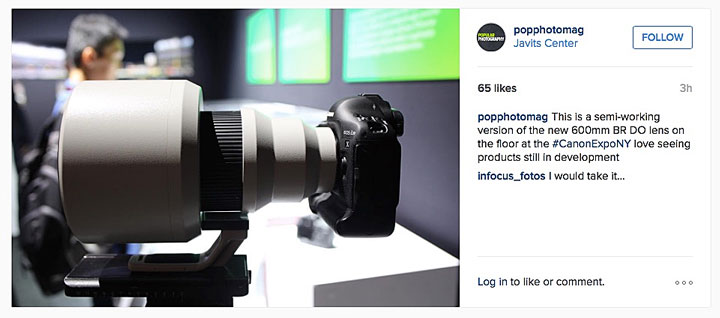 Prototype image of Canon upcoming lens Prototype of Canon EF 600mm BR DO shown at Canon Expo 2015 in NYC. Keep in mind the above shown version of the lens is just a prototype or working version of the lens. The Lens belongs to Canon DO Lenses group that inherit ultra compact light-weight design, Canon also added latest BR technology to the lens design to avoid the chromatic aberration and produce images with true color and contrast.
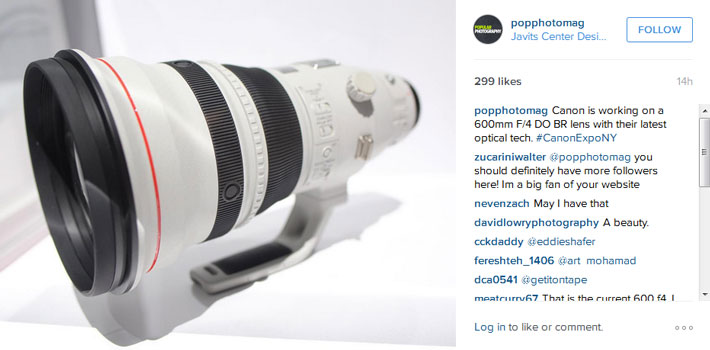 finalised version of the upcoming lens Canon BR Optics
Canon’s proprietary Blue Spectrum Refractive Optics (BR Optics) incorporate a new organic optical material with unique anomalous dispersion characteristics for use in camera lenses. The molecular design of BR Optics refracts blue light (short wavelength spectrum) to a greater degree than other existing optical technologies including UD glass, Super UD glass and Fluorite, to control color fringing as effectively as possible. When placed between convex and concave lens elements made from conventional optical glass materials, BR Optics help to produce sharp images with outstanding contrast and color fidelity by thoroughly reducing axial chromatic aberration.
We have already posted the image of Canon upcoming Megapixel monster image (may be called Canon 5DSR II). Take a look at the post here.
We will post more updates as soon as we get it, FACEBOOK | TWITTER | GOOGLE+ to get live news + rumors 24X7+
source – instagram.com/popphotomag/
|
KEEP THIS BLOG ALIVE - Support New Camera Buy Canon Lenses, Buy Music CD or Digital Camera at amazon it helps this site, and you do not pay anything extra, it is just a way to help support this site.

|
 The Olympus E-M10 showing bit more details compared to A6000 whereas the Sony A6000 show less noise with more flat image, Sony may be implemented a strong noise reduction filter algo. Both camera image is usable upto 6400 only.
The Olympus E-M10 showing bit more details compared to A6000 whereas the Sony A6000 show less noise with more flat image, Sony may be implemented a strong noise reduction filter algo. Both camera image is usable upto 6400 only.
















